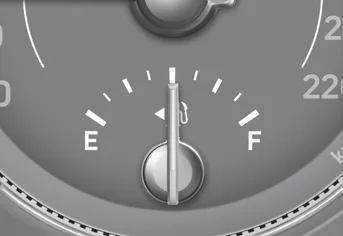Hyundai Venue (QX): Speedometer & Tachometer / Fuel gauge

This gauge indicates the approximate amount of fuel remaining in the fuel tank.
Information
- The fuel tank capacity is given in chapter 2.
- The fuel gauge is supplemented by a low fuel warning light, which will illuminate when the fuel tank is nearly empty.
- On inclines or curves, the fuel gauge pointer may fluctuate or the low fuel warning light may come on earlier than usual due to the movement of fuel in the tank.
WARNING
Running out of fuel can expose vehicle occupants to danger.
You must stop and obtain additional fuel as soon as possible after the warning light comes on or when the gauge indicator comes close to the "E (Empty)" level.
NOTICE
Avoid driving with an extremely low fuel level. Running out of fuel could cause the engine to misfire and damage the catalytic converter.
This gauge indicates the temperature of the engine coolant when the ignition switch is in the ON position. NOTICE If the gauge pointer moves beyond the normal range area toward the "H" position, it indicates overheating that may damage the engine.
This gauge indicates the current outside air temperature by 1ÂḞF (1ÂḞC). -- Temperature range: -40ÂḞF ~ 140ÂḞF (40ÂḞC ~ 60ÂḞC) Note that the temperature indicated on the LCD display may not change as quickly as the outside temperature (there may be a slight delay before the temperature changes.
Other information:
Hyundai Venue (QX) (2020-2025) Service Manual: A/C Pressure Transducer. Repair procedures
Inspection âḃ Before measuring the pressure of the refriferant line, check whether the refrigerant amount is charged in accordance with the specified charging amount.
Hyundai Venue (QX) (2020-2025) Service Manual: Rear Corner Radar Unit. Schematic diagrams
Categories
- Manuals Home
- Hyundai Venue Owners Manual
- Hyundai Venue Service Manual
- Tire Pressure Monitoring System (TPMS) (Type A)
- Child-Protector Rear Door Locks
- Components and components location
- New on site
- Most important about car
